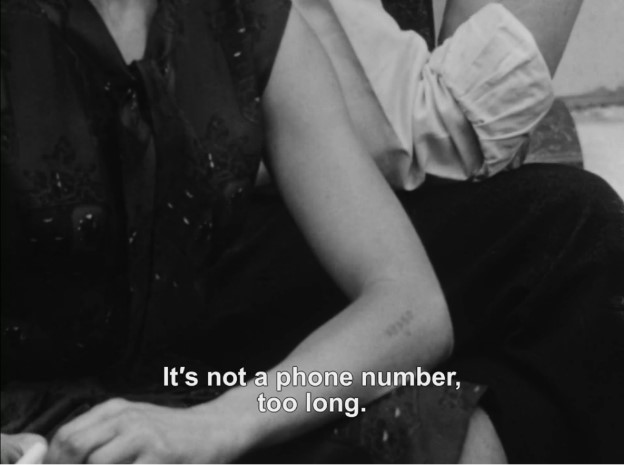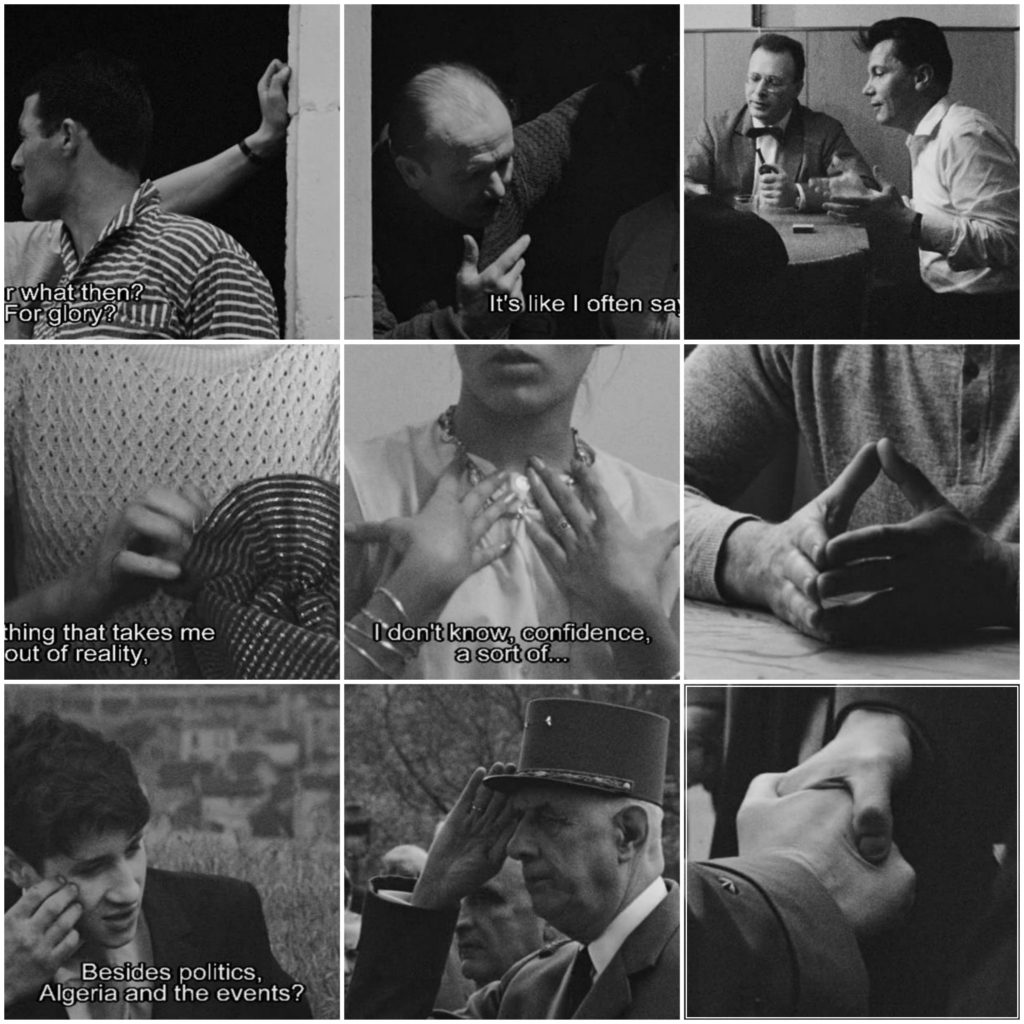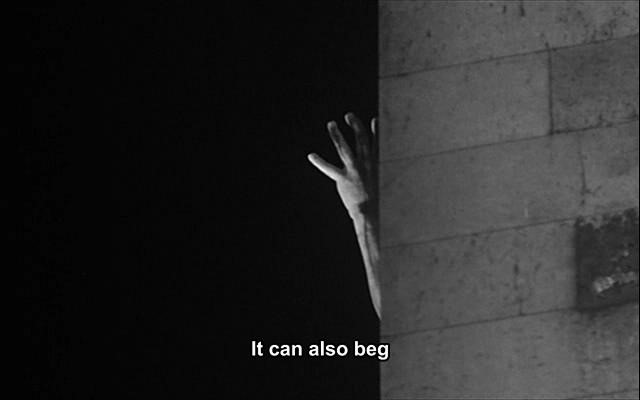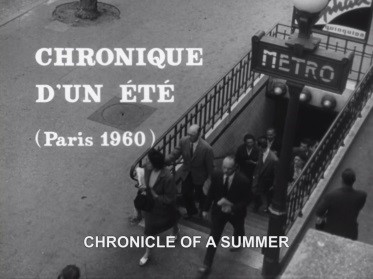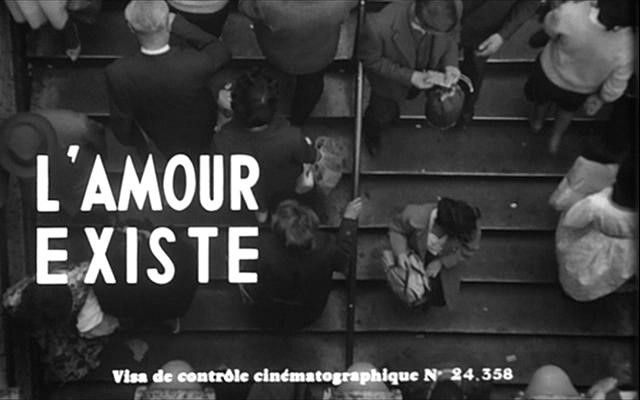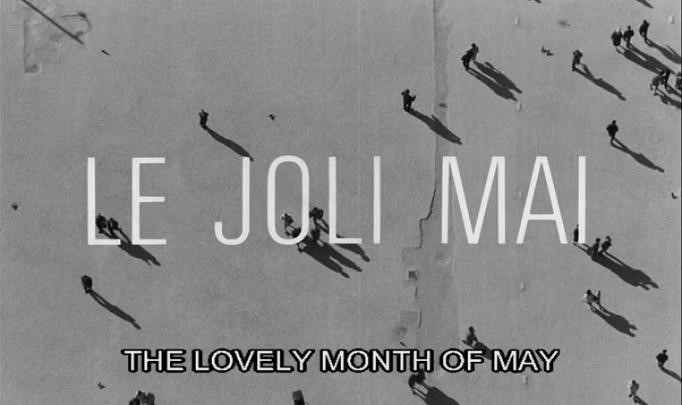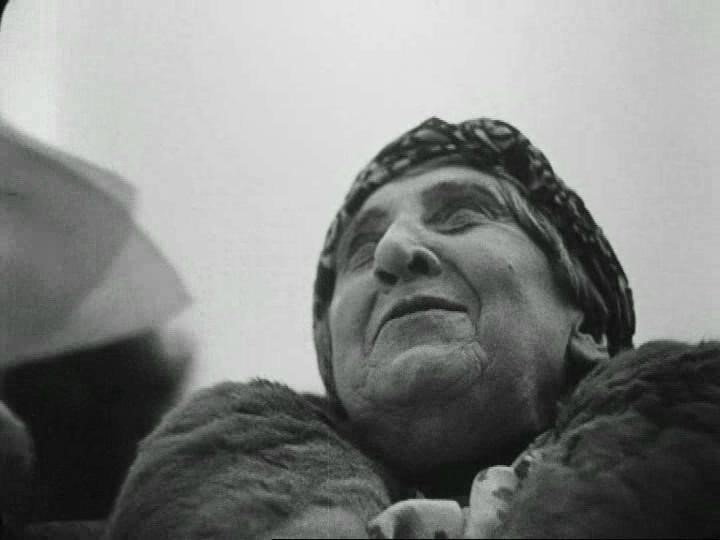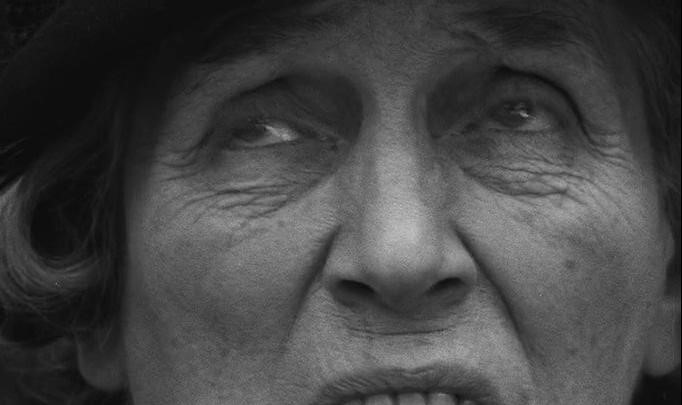Ciné-méta-vérité: Le Joli Mai and the Politics of Fictionality
Chang-Min Yu
Roger Tailleur claims in his 1963 review of Le Joli Mai (1962) that “today Chris Marker replaces other people’s ‘cinéma vérité’ with ‘cinema, my own truth’ (ciné ma-vérité), granting to this simple displacement of the link a measure of his honesty and modesty.”[1] The phrase “ciné ma-vérité” subsequently became synonymous with Marker due to his experiments in the emerging genre of cinéma vérité—an approach pioneered by Edgar Morin’s and Jean Rouch’s Chronique d’un été (1961). Yet Le Joli Mai’s formal aspects are often sidelined; the film is frequently contextualized only by its technological breakthroughs (e.g. the use of light-weight equipment). Seeing Le Joli Mai entirely as a documentary born out of technological progress hinders our ability to appreciate how its audacious aesthetic offers a means of rethinking history and its representation in documentary. In other words, Le Joli Mai’s historiographic aspiration is eclipsed under the aura of cinéma vérité. In contrast, I argue that the film presents Marker’s stylistic and cinephiliac point of view in the mode of historiography, a meta-historical writing that should be named as ciné-méta-vérité; it redefines documentary through the politics of fictionality.
Marker incorporates a sophisticated sense of mise-en-scène and editing into Le Joli Mai to put forward a non-traditional “chronicle” of the “lovely” month of May. In order to question how to narrate history, Le Joli Mai accentuates the unspoken politics of fictionality that is always in play in any documentary practice. The concept of fictionality derives from Lynn Higgins’s discussion of the “politics of style.” In her ground-breaking New Novel, New Wave, New Politics (1996), Higgins rereads French New Wave films by championing their stylistic features, which rely on the materiality of the filmic language. Her question can be simplified as follows: how can an artful film like L’Année dernière à Marienbad (1961) have anything to do with contemporaneous social and political situations?
One way is to focus on the surface of the images to examine the “foregrounding of autonomous and productive textuality.”[2] The formal innovations are so insistent that critics sometimes see them as superficial plays of forms with no substance. Higgins argues, on the contrary, that the centrality of textuality in these films demands different political questions: “[They] engage in a kind of historiography that has not yet been read as such.”[3] This insight is integral to the aesthetics of Le Joli Mai. Without denying the importance of technological progress, it might be fruitful to think through the director’s artistic choices by returning to individual scenes and imagistic discourses. I would argue that baroque fictions like L’Année dernière à Marienbad are not the only ones to achieve this stylistic reformulation of history. In a subtler form, Marker demonstrates his own kind of historiography in a seemingly straightforward account of May 1962.
Using Higgins’s words, I contend that Le Joli Mai reads Paris for “metafiction and metahistory” in its non-linear yet tightly concatenated format.[4] While Higgin’s politics of style deals mainly with fictional works and their textual frictions, my use of fictionality highlights how Le Joli Mai delicately distances the viewer from the filmic world to which a documentary is supposed to offer an entryway. In this context, the concept of fictionality points to two different means of formal distanciation. The first is to problematize the definition of documentary and its presumed opposition to fictional film through stylistic interventions—an issue that I will clarify by returning to the original ambition of cinéma vérité in Edgar Morin’s and Jean Rouch’s writings. Following this line of thought, I then ask how Marker’s ciné-méta-vérité provides a challenging historiographic model for documentary filmmaking, and how the multivalence of Marker’s images and their associations naturally directs the audience’s attention from talking heads to talking hands. The second layer of fictionality comes to locate the film within the history of cinema through Le Joli Mai’s manifold references to its cinematic predecessors. The second part of the film, “Le Retour de Fantômas,” addresses the rise of the right-wing movements in France and tacitly refers to the sedimented riverbed of cinema, already highlighted by the title that alludes to Louis Feuillade’s series.[5] These cinematic evocations demand the critic to look at the history of France presented by the film through the lens of film history.
Overdetermined as they are, the images in Le Joli Mai insist on the imbrication of reality and fictionality: “Such images, uncanny icons of a postmodern age and sensibility, have the status of a discourse that is haunted by history.”[6] Haunted, yes, not only by one history (of France), but also by an awareness of the history of cinema that belongs to this postwar generation of French directors.
A Fictional Chronicle as Ciné-méta-vérité
One way to analyze Le Joli Mai is through understanding how cinema vérité came into shape. “For a New Cinéma-vérité” is Edgar Morin’s manifesto for this new mode of documentary. From the outset of the article, he cuts to the core of cinema vérité, laying out the fundamental tension between fiction and documentary:
I am referring to the so-called documentary film and not to fictional film. Of course, it is through fictional films that the cinema has attained and continues to attain its most profound truths: truths about the relations between lovers, parents, friends; truths about feelings and passions; truths about the emotional needs of the viewer. But there is one truth that cannot be captured by fictional films, and that is the authenticity of life as it is lived.[7]
“Life as it is lived” has long been established as the criterion that separates fiction from documentary. However, with the emphasis on the tension as the formative factor in documentary filmmaking, Morin proposes that documentary should approximate fictional film without losing its own commitment to reality.
But compared with the fluidity of fiction, the camera of a documentary film is always “too heavy.” In a fictional film, there is a flowing rhythm built through the smooth logistics of the set and the repetitive takes, as if life is held off and suspended: “Cinema needs a set, a staged ceremony, a halt to life.”[8] Before Jean Rouch, cinéma vérité was “at an impasse” due to the technical difficulty of capturing humanity in motion.[9] But things have changed by 1959. For the French sociologist, with the help of lightweight equipment, the documentary filmmaker was able to make the entire world his film set, plunging into the vicissitudes of life to become a “filmmaker-diver.”[10] For Morin, documentary shed its staginess with the newly acquired mobility. It became more of a fictional film thanks to the technological revolution that enabled a different kind of spatio-temporal dynamic: “the lightness of [the camera-pen] that would allow the filmmaker to mingle in the lives of people.”[11] Morin also pointed out that the camera-pen—by exposing the film subjects in performing themselves—enables “the subjects of the film [to] recognize themselves in their own roles” and “there is a profound kinship between social life and the theater.”[12] In this characterization, cinéma vérité is about how human dramas unfold in the theater of reality that is staged by the cinematic apparatus.
The concept of staging is essential because it points to a seemingly contradictory relationship between two fundamental modes of documentary, that is, between Robert Flaherty’s and Dziga Vertov’s approaches. In “The Camera and Man,” Jean Rouch summarizes this clash in simplified but illuminating terms: “Must one ‘stage’ reality (the staging of ‘real life’) as did Flaherty, or should one, like Vertov, film ‘without awareness (‘seizing improvised life’)?”[13] Flaherty invites his filmed subjects to participate in the making of their own documentary, to reenact their own life, while Vertov insists on “recording little patches of reality” in the camera’s willingness “to show people without makeup, to seize the moment.”[14] Certainly Vertov’s “kino-eye” theory—with its particular focus on the role of editing in reconstituting reality reflexively as “thematic truth”—is not this simplistic, but from Rouch’s comparison of the two directors, we might be able to understand why Morin asserts that “[cinéma vérité’s] true father is doubtless much more Robert Flaherty than Dziga Vertov.”[15] For Morin, Flaherty’s model foregrounds the idea of staging, showing a way to find truth not in the unmediated presence of reality recorded on the celluloid, but in a mise-en-scène that is closer to a fictional film, in which the camera serves as a provocateur.
Cinéma vérité’s ambition was to allow real people to be confronted with the camera and engage in “cinematographic interrogation.”[16] The filmmaker was finally able to interrogate people with the camera without being weighed down by the equipment. Returning to the inception of cinéma vérité thus yields unexpected results. The phantom of fiction is not something to be dispelled; it should be welcomed so as to excavate a certain kind of truth buried beneath human expression. Cinéma vérité thus has a delicate relationship with truth and falsity, revealed in the process of playing “[one’s] life before the camera.”[17] Each participant puts on a mask—whether truthful or not. And the audience in turn recognizes a “truer” human interaction in the process. Provoked and mediated by the presence of the camera, the lives of people become fictionalized.
The world is a film set, then. In order to reach “truth,” documentary has to be more “fictionalized.” Yet, in terms of the format, Chronique d’un été demonstrates a progressive movement toward revelation; it is an “experience” (in the doubled sense of experiment and experience) that needs estimation and verification. Rouch and Morin talk through the collected data at the end of the film, extrapolating its significance: whether participants have a deepened understanding of themselves and whether the audience sees the underlying truth that the film is eager to capture. The problem of fiction emerges prominently in acting; there is no way to tell if, as Morin wonders in the conclusive remarks, the person in the film is only a ham, an exhibitionist or just him- or herself in any sequence. Truth is revealed and obscured by sincere histrionics.[18]
If Chronique d’un été is a lived cinema, then Le Joli Mai is a cinematized life.[19] Marker’s film is a continuation—and reformation—of Morin’s pursuit in liberating documentary from its presumed constraints. The distinction lies in how fictionality manifests itself. Chronique d’un été emphasizes the performative quality of each filmed subject’s participation, magnified through the presence of the camera. In Le Joli Mai, life itself is thoroughly reconfigured through the mise-en-scène of the film. Our understanding of the people interviewed in the film is inseparable from how these people are filmed, how specific shots are composed and edited together, and how certain commentaries enter into the discursive construction. The uncertainties stem from the form rather than from the content. The interviews are excessively editorialized so that the film is never complicit with the interviewees. It keeps its distance to posit an incisive attitude. Marker thus transposes the staging of reality in front of the camera to the staging of reality with the camera. The politics of fictionality is firstly about the disclosure of mediation.
For example, immediately after the Poet’s Fair sequence, Marker cuts to a nurse gently caressing an owl. The voiceover praises the tiny bird as “beautiful, pleasant, and deep,” and comments, “Why search for beauty in a dove and poetry in poets? When you have owls, painters, astronauts, inventors, lovers, and Pierrot the cabbie?” Presumably, this is a list of amiable figures that the film is going to introduce to the audience. Nonetheless, not all of them are exactly sympathetic. With the missing astronauts at the exhibition, the arrogant inventor and his pet spider, the earnestly naive lovers at the end of section one, the film seems to be deconstructing itself. This textual paradox precipitates intellectual distanciation.
The painter is no exception. The film shows how intriguing the self-taught painter—whose work is a fantastic mixture of surrealism and cubism—is in a supposedly positive light. The film asks us to listen to him explaining each color on the metallic canvas. When he discusses the possibility of having a local exhibition, the film cuts to several women whispering and laughing in front of paintings at a gallery, as if showing the cabbie how people would react to his talent. Is Pierrot a deluded quack or an undiscovered genius? In this case, the editing and voiceover muddle these images. In Le Joli Mai, life and its cinematic expression have a strained relationship. These scenes illustrate the opacity of cinema as a medium and how that opacity should provoke our awareness of mediation.
The opacity of the cinematic medium is further underlined through framing. This is obvious from how each shot is composed—with each interviewee, there is always something distracting, pulling the audience’s attention away. With the first interviewee, the suits salesman, while his face occupies most of the frame, a toddler and a boy are seen in the upper left background, moving in and out of the shot. Their marginal movements beg for attention. This is not something unusual for a documentary shot on location, but almost every interview has such diverting details (and Marker takes advantage of them profusely.) This approach demands the audience to put things “in perspective”—a possible dialogic relation emerges and proffers competing interpretations. This heteroglossic configuration is also the basis of what I later discuss as Marker’s rhyming montage in Le Joli Mai.
Tenacious Irresolution
Marker’s reflexivity went through its evolution even in his early career. His early short films like Dimanche à Pekin (1956) and Cuba Sí! (1961) show the Communist societies playfully in glamourous national solidarity, before one knew they were destined toward destruction (e.g. the Cultural Revolution in China and the dictatorship of Fidel Castro.) Both films are products of a specific convergence of historical forces—the colonial context of the Algerian war and the cultural expansion of American consumerism—in the late 1950s. In a 1998 retrospective held at the Cinémathèque Française, Marker stated that he “was not prepared to show any work prior to 1962.”[20] In suppressing these early works, he perhaps felt that his approach had been facile and tendentious. His earlier films are melodious multimedia meditations on societies in transition, their eulogistic tone insufficient to reflect upon the political significance of the images they generate. One exception is the repetitive sequence in Lettre de Sibérie (1957), in which three ideologically charged voiceovers are juxtaposed to narrate the same scene of street workers in Yakutsk. But even there, the third, “simple” voiceover doesn’t appear quite neutral in presenting the facts. This nascent reflexivity later evolved into the historiographic innovations of Le Joli Mai.
The reflexivity of Le Joli Mai is understated, as observed in Marker’s carefully inserted subtitles. For instance, in the second part of the film, when the crew is investigating the people’s reaction to the ongoing political events, a woman bursts into the scene and accuses the cameramen of being the state lackeys propelling France into another war. When a bystander urges her to go to Russia, she retorts that if she could speak the language, she would. “You don’t need to go there to know it,” she yells. The caption on screen indicates that this is all a “fatal misunderstanding.” And through this superimposed line, Marker slyly modulates the implied meaning of the scene. Given his sympathy toward communism, Marker might be simply voicing a bemused sentiment with the added ellipsis (“fatale méprise…”).[21] While this supposed misunderstanding (or “mépris”) suggests the filmmakers’ mistaken roles (“state lackeys”), it also intimates the woman’s misconception of people’s well-being in Russia. This efficient line sets up alternate paths for interpretation, evincing a multivalence that shapes the film in general. If, as Steven Ungar asserts, Le Joli Mai is a “proto-political film,” the refreshing radicality lies in its tangential, multivalent stance toward the issues it raises.[22]
This tenacious irresolution can appear equally troubling. Sarah Cooper argues that “the most unsettling aspect of this film—as well as its strength, in so far as it avoids moralizing—is that it does not present a clear stance on how people should be or behave: it just enters into a permanently interrogative relation to their lives.”[23] It is almost as if the “unsettling aspect” provides no firm ground to posit an actionable political agenda. If anything, the multivalence in Le Joli Mai does not seek to portray the film itself, in Cooper’s words, as a “happy medium.” The colloquial sense of the term—reaching a compromise between two extreme options—is never fulfilled. The issue here is the inquisitive mode of address rather than the content of the question. The film would never reach a happy conclusion because, as Cooper herself recognizes, the film asks us to adopt an “interrogative relation” with the lives of Parisians.
Marker’s cinematographic interrogation requires suspending a conclusive judgment (contra Chronique d’un été); the film merely pleads for solidarity, as we have heard in the final voiceover: “…as long as despair exists, you’re not happy.” It does not issue a final verdict on the lives of people and tell them how to think. Le Joli Mai reveals a self-consciousness critical of its own version of truth and admits that any historiography is an ideological choice. Higgins observes a similar hesitation regarding political commitments in the concurrent nouvelle vague and nouveau roman movement. She contends that “If these artists fail in their efforts to be committed, it is because of their inability to write or film their way out of an impasse.”[24] This impasse itself is worrisome and promising at the same time. It is worrisome because it provides only an elusive hermeneutic scenario (like that of Pierrot the cabbie) without resolution. This kind of impasse is also promising because it defies any form of didacticism that presents history “as it is” with unquestionable certainty. To propose a ciné-méta-vérité, fictionality plays an obligatory role in redefining documentary’s historiographic model and its assumptions of transparency and authority.
When recalling the cultural atmosphere in 1960s France, Kristin Ross writes, “The everyday, it seems, must first be fictionalized in order to be thought.”[25] While she examines Roland Barthes and Henri Lefebvre’s writings, I argue that fictionality, in the wake of the nouvelle vague, plays a more prominent role in French cinema. However, to interpret a documentary in the framework of fictionality is tricky, because it primarily defines itself as a document of reality. And Le Joli Mai is a documentary that appears to present to the audience an account of May 1962 with its branded date on the beginning of each segment. Marker’s aesthetics secretly subverts this superficial impression the audience might have. With each interview raising various social, cultural, and political issues in the film, we often find ourselves convinced of its significance but unsure of its extrapolation—a persisting deliberation process that is supported by the film’s textual strategies.
Another strategy adopted by Le Joli Mai is to move away from documentary’s focus on the interviewee’s face as the usual guarantee of trustworthiness, whose mistaken sincerity is exactly the myth Chronique d’un été exposes in its emphasis on inter-facial interactions. Marker no longer asks us to regard talking heads as windows into one’s interiority; he stages “talking hands” to make the meaning of each sequence more multivalent. The sometimes-expressionless faces of Marker’s interviewees are animated through their expressive gestures to which the constantly moving camera intentionally directs the audience’s attention. This practice, I believe, is inspired by a confrontational moment in Chronique d’un été.
Talking Hands, Not Talking Heads: the Tattoo Moment
In Chronique d’un été, there is one particular shot—albeit a short one, about one second—that becomes a touchstone for Le Joli Mai. In one of the gatherings, Morin asks the African students seated next to him about the tattoo on Marceline’s arm. The students have no clue. One student jokes that it might be something that a sailor would have. Marceline isn’t offended. She patiently explains the provenance of the corporeal mark. The film cuts to her arm, briefly, before returning to her face. This is what I call a “tattoo moment.” The body is silent yet eloquent. For sure, Rouch’s and Morin’s provocative glance at the tattoo is less about Marceline herself than about the students, whose embarrassment is further complicated by colonial and racial issues—the ongoing Algerian war and the implication that the Holocaust should be universally acknowledged without considering people’s cultural differences. However, Marceline appears equally uncomfortable due to her stated preference for not dating people of color.[26] The character’s bodily mark tells more about her than facial expression and verbal communication. The intentional drifting of the camera highlights the corporeality and gestures of the filmed subject.
In this vein, people’s faces no longer need to be the sole trajectory of documentary. Focusing on the hands of the interviewees, Le Joli Mai is a gestural film well before Giorgio Agamben’s and Vilem Flusser’s theorization.[27] The camera does not fix on the interviewee’s face. It tends to waver and hesitate, moving down to unveil the unconscious physical actions. The oscillating camera has been persistent in repositioning the audience’s perception. It puts the interviewee and the scene’s other elements in a curious tension to create what I refer as “inter-views.” As the film progresses into the second part, the audience sees less and less distraction from the surroundings. Le Joli Mai seems to move from the multivalent framing to the involuntary gestures of the filmed subject. Put otherwise, the film displaces and condenses its centrifugal propensity to include fleeting minutiae—after all, the politically charged second section of the film demands a much more focused aesthetics. The hand surfaces in such a transition.
If the face is the conscious entrance to the inner world of an individual, then the hand is a more involuntary and multivalent sign. It presents how the body reacts to the outer milieu in its somatic expression. French paleontologist André Leroi-Gourhan, who was writing his magnum opus Le Geste et la parole (1965) around the same time, elucidates that “hand actions are closely coordinated with those of the anterior organs of the face”[28] and “a link therefore exists between the hand and the facial organs, and the twin poles of the anterior field attest their equal participation in the construction of communication symbols.”[29] But for most of the first half of the twentieth century, the hand was rarely in the cinematic spotlight.[30] It was only in the 1960s that the human digits gradually gained prominence on screen. For example, Paul Arthur argues that 1960s North American portrait films “favor frontal mid-range compositions in which a subject’s face and hands are privileged foci of information and/or expression.”[31]
Manual operation is exquisitely captured in Le Joli Mai. During the interview with the African student, the camera tilts down to see his hands. The interviewer asks “what about [the whites] in Africa?” The student’s hands are relaxed at first, neither straightened nor clenched, but when the white governor in Africa becomes the subject of discussion, they turn into two fists, as if they are a sign of power or indignation. Then, in a more fascinating turn, one of his hands becomes the conducting gesture of the governor under the patient gaze of the camera: commanding African people to run around, to parade before him. In another case, the ex-priest details how he chose between the brotherhood of communism and his faith. The camera again turns downward to show his hands—first the two hands stay lethargic when the voice describes the church’s initial involvement with the unions. And when the ex-priest’s narrative gets to his gradual conversion to communism and solidarity, the hands are gesticulating more and more energetically, as if they were finally liberated from the struggle between faith and people. The obsessive gaze at the hands necessitates an engaged reading—both in the political sense and in the way the camera fixes the audience’s perception of these often neglected yet revealing movements. If there is “truth” in this mode of filmmaking, then its mission is to ask us to read the image and word as well as the gesture of a character.
Manual operation also involves “manual labor.” Later in the interview with the Algerian student, the film cuts to laborers working on the street. “The voice-over commentary states that the working class in France extends downward toward a sub-proletariat typically made up of manual laborers from colonized territories… It was as though practices of cheap manual labor implemented in occupied overseas territories had been brought home,” writes Steven Ungar.[32] One interviewee already brought up this social and economic aspect of the hand in the first section. Just before the final interview from the first section, the film shows us an “inventor of stabilizers for light vehicles.” He claims that “Luck plays a big part in life, but the best luck is the hands. They’re the best capital you can have.” What the hand means for him is a bootstrapping attitude—a meritocratic ideology that invests in the exceptional genius’s individual achievement. This is why the film later sets up a scene of working immigrants to counterbalance this claim. The audience may or may not believe the hand is the way to success, but it is only one side to the story. The hand represents capitalistic individuality, yet it also signifies suffering collectivity. The hand is thus an expressive means as well as a socio-political sign to which the film constantly returns.
The gesture itself is historically charged as well, such as President de Gaulle’s salute, handshake, and a newlywed’s raised hand, showing her ring. These are the moments when we suddenly come into contact with the historicity of gestures. These stand out because we understand that they convey a message not only by the person who makes the gesture, but also by a broader social and cultural milieu that predetermines and overdetermines its significance. Therefore, Le Joli Mai invites us to make this comparison among a multitude of gestures in their multivalence. Furthermore, multivalence connotes a possibility of swift reversal. Maurice Pialat’s L’Amour existe (1960) puts this turnabout in a poetic manner: “The hand of glory, ordering and directing, can also beg. A simple change of angle is enough.”
Histoire(s) du cinéma
L’Amour existe leads us from the historicity of a gesture to the historicity of the image. Pialat’s short film, composed of bare glimpses at the banlieue settings in the outskirts of Paris, offers a personal rumination on the marginalized social classes in France’s postwar modernization through a poetic voice-over commentary.[33] More importantly, it seems to be an iconographic forerunner for cinéma vérité. It is as if the respective openings of Chronique and Le Joli Mai draw on that of L’Amour existe. Morin and Rouch decide to adjust their framing from the overhead composition to a less alienating 45-degree angle, while Marker and Lhomme pursue a distancing but “passionate objectivity.”[34] Similar images migrate from one film to the next; each has added connotations from previous exemplifications.[35] Both L’Amour existe and Le Joli Mai display an aerial view in the title sequence. The only difference in terms of shot composition is the scale. One such similarity might be coincidental, but these two films resemble each other in so many ways (with the enumeration of statistics, the tracking shots around the city, the overhead shot, etc.) that ask the audience to actively seek these correlations.
Much like L’Amour existe, Le Joli Mai is composed with long tracking shots and contemplative voiceovers. Much like Chronique d’un été, Le Joli Mai is assembled with the interviews. These remarks might seem to accuse Marker of plagiarism, but the creative evocation of filmic references allows him to approach the historicity of the image. In Le Joli Mai, the politics of fictionality—beyond provoking the audience’s awareness of mediation—is about intertextual references as well. These intertextual allusions complicate the interpretation of a period of history (May 1962) as represented in the film. This complication invites the audience to understand the film not as a straightforward historical account, but as histories of May 1962 that are imbricated with cinematic references and their potency.
The fictional seepage is most prominent in the film’s montage. In contrast to the linear advancement of Chronique d’un été, Marker presents us with a kaleidoscopic view of Paris, tightly chained by associations. That is, one marginal element in a shot might later reveal its subsequent echoes in the next sequence. It also provides a chance for Marker to pay his tribute to Fritz Lang, whose ingenuous montage is redeployed here to create a different kind of city symphony. In his discussion of Das Testament des Dr. Mabuse (1933), Tom Gunning asserts that “the editing between sequences draws attention to itself in a manner just as striking as the cuts to Mabuse, or Haghi, in the earlier films, but again without making a connection to a single over-seeing consciousness … these shots share some common element, formal or semantic, so that one of the shots seem [sic] to reply, reflect, comment on, or even parody the other.”[36] Marker does something quite similar to turn his individual interviews into urban inter-views, leading the audience from one scene to another by an implicit but insistent connection with the “noises” around each interviewee.
In the scene of the inventor who believes “[hands] are the best capital you can have,” a group of soldiers are moving about in the background. The film then cuts right into the next interview of a solider stationed in Algeria and his girlfriend. The presence of the soldiers in the previous scene is then retroactively understood. In another instance, the African student from Dahomey is introduced through the previous scene’s discussion of freedom. The first question posed to him is “Are freedom and independence also temptations from the West?” This rhyming montage allows Marker to delineate how these interviews can turn into inter-views by an associative logic of montage that highlights recurring details within the cityscape of Paris. The city itself is like an echo chamber in which fragments of people’s lives reverberate with each other. From this perspective, perhaps we can put Le Joli Mai together with Jean-Luc Godard’s Le Mépris (1963), both honoring Lang in different ways. The latter, with the flair of a Cahier critic, puts the German director front and center, telling a story about cinema through Lang’s onscreen incarnation. The former imitates Lang’s montage and Dr. Mabuse’s clandestine operations, building thematic echoes upon editing and smuggling filmic references into a seeming documentary.
This intertextual intention is already introduced at the beginning of the film. Le Joli Mai opens with a shot of a woman climbing a pyramidal structure of glass and steel. It brings into mind one of the first sound films, Sous les toits de Paris (1930), which opens with a slow tracking shot atop the roof penetrating through the smoke to disclose the life below. The building the woman climbs is none other than a cinema theater. According to Lhomme, “this is the roof of the oldest and biggest cinema in Europe—the Gaumont Palace. It’s since been destroyed and no longer exists—neither does the women’s prison that is important at the end of the film.”[37] With the Gaumont Palace as the backdrop, it is as if the film were staging a scene in which, after the woman saw Sous les toits de Paris, she decided to scale the theater for a better view of Paris.
And immediately afterwards, the opening narration alludes to the figure of a detective. This reference probably originates from Le Mystère de l’atelier quinze (1957), a lesser known short film of André Heinrich (the producer of Le Joli Mai), Resnais, and Marker. In this film, the occupational health and safety doctor becomes a private eye seeking to detect the cause behind the invisible threat to the health of factory workers. There is also a better-known reference to another detective figure in their Toute la mémoire du monde (1956). The short film mischievously misguides the audience to believe that Dick Tracy comic strips were part of the Bibliothèque Nationale collection.[38] These earlier films become part of the archive that shapes Le Joli Mai. The film winks at the audience by relating cinema to the figure of the detective. Either we need a detective to see these images anew, assisted by the history of cinema, or we need cinema—acting as our private eye—to teach us to play this hide-and-seek game with images.
Speaking of hide-and-seek, the fact that the film begins above the rooftops of Paris reminds the audience of the sneaking Fantômas who traverses the city unseen through secret paths of slopes and planks in Louis Feuillade’s series. The Feuillade connection is further demonstrated by the title of the second section, one of the few highlighted references. What Fantômas discloses, moreover, is the associations with surrealism. Surrealism favors the reversibility between the visual and the verbal, as shown in Stuart Liebman’s scrupulous analysis of puns Un Chien andalou (1929)— such as the famous “coup d’oeil” (slicing of the eye) and its phrasal reversal like “oeil de coup ” that lead the viewer back to its preceding shot: the moon as the “oeil de cul” (anus) with the phonetic conversion from coup (slicing) to cul (ass).[39] Robert Stam astutely observes that a similar trick of visual-verbal equivalence appears with one shot of the Arc de Triomphe at the end, as if the “l’arc” (both a figurative keyhole and an audial nod to the English word “lock”) was to be opened by the “key” pictured in the beginning—the imposing Eiffel tower. The landmark’s lattice structure resembles a metal stem.[40] The key, as narrated in the pointillist opening sequence, provides an aerial vision.[41] This might also be the key which Michel Legrand refers to in the song he composed for the film: “the key to our histoire.”
The surrealist fascination with the suffused atmosphere of magic in Feuillade’s series is reworked in the final accelerated sequence of the Arc de Triomphe. Time-lapse photography transforms the streets of Paris into overlapping streams of light, as if we’re seeing the tracing of astral objects. The eerie and uncanny nature of Paris is on display, as in Louis Aragon’s Le Paysan de Paris (1926) and André Breton’s Nadja (1928).[42] The transition from the ordinary to the surreal demonstrates Marker’s orchestration of fictionalized documentary—how he appropriates literary and filmic sources to comment on contemporary French society. Close to the end of the film, an old woman looks upward and seems lost among tombstones, statues, Hans Hemling’s Allegory of Chastity (1475), and Paolo Uccello’s Saint Georges and the Dragon (1430-1435). The audience ponders over what she is looking at. But the same gaze already appears in Jean Vigo’s À propos de Nice (1930). There, preceded by the shots of angelic statues in a cemetery, an old woman looks at girls frantically dancing in the carnival parade, intercut with shots of factory smokestacks. These two montage sequences disclose a similar relationship between the gaze and death through the figure of an old woman. Marker’s invocation of Vigo’s melancholic sequence reflects his own belief that, in order to see Paris clearly, one has to go back to the history of cinema, to be trained by cinematic visions. Through the old woman’s fearful gaze, Marker’s acknowledgement of Vigo’s macabre satire crystallizes his own “documented point of view.”[43]
Paris, the Most Beautiful Set in the World…
These quotations and transmutations attest to Marker’s cinematic repertoire. Le Joli Mai, building on Chronique d’un été and cinéma vérité, is an iconographic experiment and a “cinematographic interrogation” that is directed at the medium and its opaqueness. Through the in-shot camera panning and tilting, the film introduces a tense openness, maybe even heteroglossia, broadening interviews into “inter-views.” Both the hand and the unsettled cinematic references amplify the inherent polysemousness in Marker’s politics of fictionality. Moreover, the interlocking sequences usher in a rhythm that is uniquely “Langian.” To tell the history of France, the history of cinema should not and cannot be absent. Paris, in the words of the narrator at the beginning, is the “most beautiful set in the world.” To be commensurate with this assertion, Le Joli Mai becomes a collection of images with histories of their own. Its political and aesthetic multivalence is a radical strategy to rethink the possibility of documentary. Radical in the sense as extrapolated by Sam Di Iorio: “This idiosyncratic verité portrait of 1962, then, can be considered a direct springboard to the militant cinema of 1968. One May contains the seeds of another.”[44] Taking Di Iorio’s conclusion in the context of Marker’s thoughtful puzzle of images, we might also add that one film contains the seeds of others. The postwar history of France is inextricable from the history of its images.
Chang-Min Yu is a PhD candidate in the film studies program at the University of Iowa. His articles have appeared in Film Criticism and Quarterly Review of Film and Video. He has also translated the works of Jean-François Lyotard and Christian Metz into Chinese. His current research interests lie in corporeal cinema, French cinema, and figural studies.
Notes
[1].“Au cinéma-vérité des autres, [Marker] substitue aujourd’hui le ciné-ma vérité, donnant par ce simple déplacement d’un trait d’union la mesure de son honnêteté et de sa modestie” (83). See Roger Tailleur’s “Parisiennes,” Artsept 2, April-June 1963.
[2]. Lynn Higgins, New Novel, New Wave, New Politics: Fiction and the Representation of History in Postwar France (Lincoln: University of Nebraska Press, 1996), 2.
[3]. Ibid.
[4]. Lynn Higgins, New Novel, New Wave, New Politics, 15.
[5]. In an interview, co-director Pierre Lhomme explicitly refers to “the army officers who tried to organize a putsch because they didn’t like the peace accord with Algeria” (14). See Richard Portman and Sandy Flitterman-Lewis. “Passionate Cinematography: An Interview with Pierre Lhomme.” Cineaste 39, no. 1 (2013): 10–15.
[6]. Lynn Higgins, New Novel, New Wave, New Politics, 16.
[7]. Edgar Morin, “Chronicle of a Film,” in Jean Rouch’s Ciné-Ethnography, ed. and trans. Steven Feld (Minneapolis: University of Minnesota Press, 2003), 229.
[8]. Morin, “Chronicle of a Film,” 230.
[9]. According to Morin, cinema was at an impasse because it could not “penetrate the depth of daily life” to “[steal] snatches of life” (230) due to its mechanical conspicuousness. That is to say, the bulkiness of the cinematic apparatus thwarted cinema’s mission of becoming a “spy.”
[10]. Surely Morin is referring to the “ground-breaking” documentary, Le Monde du silence (1956).
[11]. Ibid, 231.
[12]. Ibid, 232.
[13]. Jean Rouch, “The Camera and Man,” in Jean Rouch’s Ciné-Ethnography, ed. and trans. Steven Feld (Minneapolis: University of Minnesota Press, 2003), 33.
[14]. Jean Rouch, “The Camera and Man,” 32.
[15]. Morin, “Chronicle of a Film,” 231.
[16]. Ibid, 232.
[17]. Ibid. For an in-depth analysis of the relationship between Chronique d’un été and psychodrama experiments, see Ivone Margulies’s “A Sort of ‘Psychodrama’: cinéma vérité and France’s self-analysis,” South Central Review 33, no. 2 (Summer 2016): 68-79.
[18]. Both Marceline and Marilù are the obvious cases in Chronique and I intend to explicate this issue of sincerity by focusing on the cinematic exposition of Marceline’s tattoo later.
[19]. Sam Di Iorio phrases this slightly differently: “If Rouch and Morin’s film focuses on individuals, Le Joli Mai is edited around themes” (46). See Sam Di Iorio, “The Truth about Paris,” Film Comment 39, no. 3 (2003): 46–47.
[20]. Sarah Cooper, Chris Marker (Manchester: Manchester University Press, 2008), 35.
[21]. This is also a title of a Georges Méliès film from 1899.
[22]. See Steven Ungar, Critical Mass: Social Documentary in France (1928-1963) (Minneapolis: University of Minnesota Press, forthcoming).
[23]. Sarah Cooper, Chris Marker, 39.
[24]. Higgins, New Novel, New Wave, New Politics, 13.
[25]. Kristin Ross, “Yesterday’s Critique, Today’s Mythologies,” Contemporary French and Francophone Studies 12, no. 2 (April 1, 2008): 236.
[26]. This sudden revelation of racism is echoed in the Paris Fair sequence of Le Joli Mai: one women, when asked about how she would use the plastic tubes given to her at the venue, said, “I chose the small ones. Necklaces for the negroes in Madagascar.”
[27]. Agamben argues that due to mass mechanization and production in the twentieth century, pace Walter Benjamin, human gestures have been standardized and lost their own creative vitality. Cinema is one way to redeem the forgone potential. See Giorgio Agamben, “Notes on Gesture,” in Means Without End, trans. V. Binetti and C. Casarino (Minneapolis: University of Minnesota Press, 2000) and Vilem Flusser, Gestures, trans. Nancy Ann Roth (Minneapolis: University of Minnesota Press, 2014).
[28]. André Leroi-Gourhan, Gesture and Speech, trans. Anna Bostock Berger (Cambridge, Mass.: MIT Press, 1993), 83.
[29]. Ibid, 113.
[30]. Two precursors come to mind. One is in Michelangelo Antonioni’s Le amiche (1955). In one of the last sequences, Clelia comes back to talk to her lover Lorenzo for the last time. Antonioni frames the two characters in an oblique way. We see Lorenzo on one side and the hands of the female character on the other. Her hands move restlessly, as if her words cannot accurately convey their meaning. Another instance is from Primary (1960). Standing before a packed audience, Jacqueline Kennedy, filmed from behind, wrings her gloved hands. I am certain more examples could be found in German Expressionism in which a manual shot might be used as part of a murderous grammar (pace Karla Oeler), but itself rarely multivalent.
[31]. Paul Arthur, “No Longer Absolute: Portraiture in American Avant-Garde and Documentary Films of the Sixities,” in Rites of Realism: Essays on Corporeal Cinema, ed. Ivone Margulies (Durham: Duke University Press, 2003), 95.
[32]. See Critical Mass, especially the chapter on Le Joli Mai.
[33]. Marja Warehime, Maurice Pialat (Manchester: Manchester University Press, 2006), 20.
[34]. See Chris Marker, “L’objectivité passionnée,” Jeune Cinema 15, May 1966 : 12-13.
[35]. Aby Warburg’s last project, Mnemosyne Atlas, is the first major work to illustrate the migratory transformation of figures and icons. See Georges Didi-Huberman, L’Image survivante: Histoire de l’art et temps des fantômes selon Aby Warburg (Paris: Les Éditions de Minuit, 2002).
[36]. Tom Gunning, The Films of Fritz Lang: Allegories of Vision and Modernity (London: British Film Institute, 2000), 144.
[37]. Porton and Flitterman-Lewis, “Passionate Cinematography,” 12.
[38]. Later, just after the interview with the communist priest, the film shows a series of comics, serving a bridge between faith (Christ) and science fiction (mutants and aliens).
[39] Stuart Liebman, “Un Chien Andalou: The Talking Cure,” Dada/Surrealism 15, no. 1 (January 1, 1986): 143–58.
[40]. This observation is included as a footnote to Geneviève Van Cauwenberge’s PhD thesis on page 104. See Geneviève Van Cauwenberge, Chris Marker and French Documentary Filmmaking: 1962-1982, PhD dissertation, New York University (Ann Arbor: UMI, 1992).
[41]. About ten years before Le Joli Mai, Marker authored three articles in Regards neufs sur le cinéma (1953), one of which was on Carl Dreyer’s La Passion de Jeanne d’arc (1928). In the piece, he already speaks of “images-clefs” (258). See Jacques Chevalier ed., Regards neufs sur le cinéma (Paris: Éditions du Seuil, 1953). I want to thank Steven Ungar for sharing this precious information with me.
[42]. A more obscure connection is to André Sauvage’s Études sur Paris (1928), in which the underground water canal is photographed in an immersive darkness, as if the boat itself were a starship. The American experimental documentary, Koyaanisqatsi (1982), later pays tribute to this sequence with its time-lapse cinematography.
[43]. The concept of a “documented point of view” comes from Jean Vigo’s “Toward a Social Cinema.” See Jean Vigo, “Toward a Social Cinema,” Millennium Film Journal, no. 1 (1977): 21–24. Vigo’s “Toward a Social Cinema” was also included in Regards neufs sur le cinéma.
[44]. Di Iorio, “The Truth about Paris,” 47.

